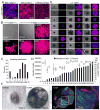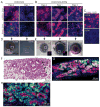A synthetic niche for nephron progenitor cells
- PMID: 26190145
- PMCID: PMC4519427
- DOI: 10.1016/j.devcel.2015.06.021
A synthetic niche for nephron progenitor cells
Abstract
FGF, BMP, and WNT balance embryonic nephron progenitor cell (NPC) renewal and differentiation. By modulating these pathways, we have created an in vitro niche in which NPCs from embryonic kidneys or derived from human embryonic stem cells can be propagated. NPC cultures expanded up to one billion-fold in this environment can be induced to form tubules expressing nephron differentiation markers. Single-cell culture reveals phenotypic variability within the early CITED1-expressing NPC compartment, indicating that it is a mixture of cells with varying progenitor potential. Furthermore, we find that the developmental age of NPCs does not correlate with propagation capacity, indicating that cessation of nephrogenesis is related to factors other than an intrinsic clock. This in vitro nephron progenitor niche will have important applications for expansion of cells for engraftment and will facilitate investigation of mechanisms that determine the balance between renewal and differentiation in these cells.
Copyright © 2015 Elsevier Inc. All rights reserved.
Figures







References
-
- Amit M, Carpenter MK, Inokuma MS, Chiu CP, Harris CP, Waknitz MA, Itskovitz-Eldor J, Thomson JA. Clonally derived human embryonic stem cell lines maintain pluripotency and proliferative potential for prolonged periods of culture. Dev Biol. 2000;227:271–278. - PubMed
-
- Bach LA, Hale LJ. Insulin-like growth factors and kidney disease. Am J Kidney Dis. 2015;65:327–336. - PubMed
Publication types
MeSH terms
Substances
Grants and funding
LinkOut - more resources
Full Text Sources
Other Literature Sources

